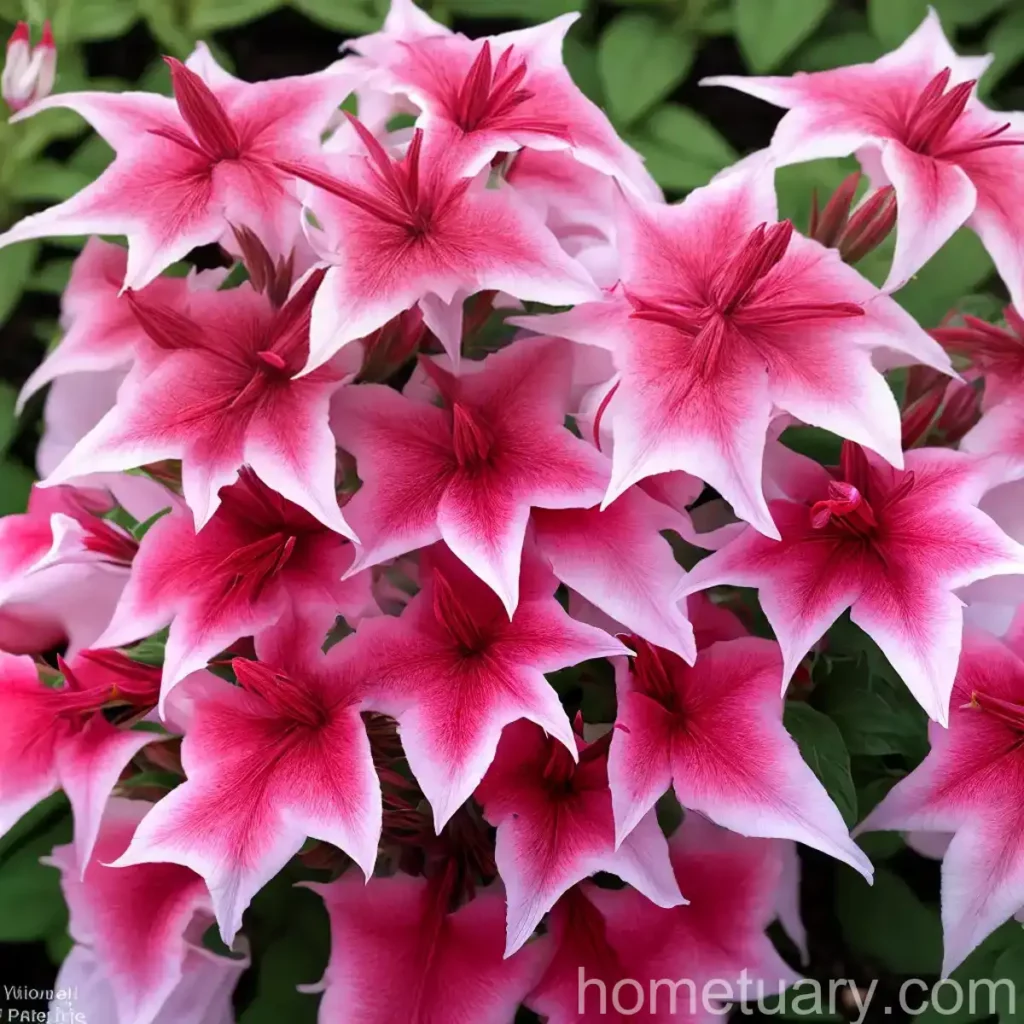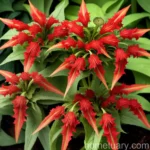Plant Name: Cardinal Flower (Lobelia ‘Cotton Candy’)
Introduction
Plants have always fascinated humanity with their stunning diversity and unique characteristics. Among the myriad of plant species, the cardinal flower, scientifically known as Lobelia ‘Cotton Candy’, stands out as a striking and vibrant specimen that captivates both amateur and professional gardeners alike. This blog post will delve into the various facets of the cardinal flower, ranging from its cultural requirements to its ecological significance and propagation methods.
What is the Cardinal Flower (Lobelia ‘Cotton Candy’)?
The cardinal flower, Lobelia ‘Cotton Candy’, is a cultivar of the species Lobelia cardinalis, commonly referred to as the cardinal flower. This perennial plant belongs to the family Campanulaceae and is native to the Americas, particularly the eastern and central regions of the continent. Renowned for its brilliant red flowers and attractive foliage, the cardinal flower is a popular choice for gardeners seeking to introduce vibrant colors and wildlife-friendly elements to their landscapes.
Key Takeaways – Cardinal Flower (Lobelia ‘Cotton Candy’)
Before diving into the specifics of cultivating and caring for the cardinal flower, it’s pivotal to grasp several key takeaways about this remarkable plant.
- Scientific Name: Lobelia cardinalis ‘Cotton Candy’
- Common Name: Cardinal flower plant
- Cultivar: ‘Cotton Candy’
- Family: Campanulaceae
- Type: Perennial
- Native Habitat: Americas
- Primary Feature: Striking red flowers
- Ecological Role: Wildlife habitat and pollinator attractant
Culture
Cultivating the cardinal flower, Lobelia ‘Cotton Candy’, entails understanding its cultural requirements, encompassing various aspects such as water, sunlight, soil, and fertilizer.
Uses
Before delving into the specific cultural requirements, it’s vital to highlight the cardinal flower’s diverse uses and benefits, both from a horticultural and ecological standpoint.
Horticultural Uses
The cardinal flower holds significant value in horticulture owing to its:
- Ornamental Appeal: The vibrant red flowers and attractive foliage make it a prized ornamental plant.
- Wildlife-Friendly Attributes: It serves as a valuable food and habitat source for pollinators and other wildlife species.
- Landscaping Potential: Its striking appearance and ecological benefits render it a compelling addition to gardens and landscape designs.
Ecological Significance
Beyond its ornamental appeal, the cardinal flower also plays a pivotal role in promoting biodiversity and supporting local ecosystems, primarily due to its:
- Wildlife Habitat: The nectar-rich flowers attract a plethora of pollinators, including butterflies, bees, and hummingbirds, thereby enhancing local biodiversity.
- Erosion Control: Its robust root system aids in soil stabilization and erosion prevention in riparian and wetland habitats.
- Conservation Significance: In several regions, including parts of its native range, the cardinal flower is considered a species of conservation interest, further emphasizing its ecological importance.
Water
Proper management of water is crucial for ensuring the cardinal flower’s health and vigor. Understanding its water requirements is integral to its successful cultivation.
| Water Requirement | Description |
|---|---|
| Moisture Levels | Prefers consistently moist soil, particularly in the heat of summer. |
| Avoid Waterlogging | While it thrives in moist conditions, it is essential to prevent waterlogging, which can lead to root rot. |
| Watering Schedule | Regular watering during dry periods is pivotal, especially for newly planted specimens. |
Sunlight
Adequate sunlight is instrumental in promoting robust growth and prolific flowering in the cardinal flower. Understanding its sunlight requirements is crucial for successful cultivation.
| Sunlight Requirement | Description |
|---|---|
| Optimal Conditions | Thrives in partial to full sun, with a preference for at least 6 hours of direct sunlight per day. |
| Shade Tolerance | While it enjoys ample sunlight, it exhibits a degree of shade tolerance, particularly in hot climates. |
| Morning Sun | In regions with intense afternoon heat, providing morning sun and afternoon shade can be beneficial. |
Fertilizer
Supplemental fertilization can aid in bolstering the cardinal flower’s growth and flowering performance. Understanding its fertilizer needs is pivotal for optimizing its health and vigor.
| Fertilizer Application | Description |
|---|---|
| Fertilizer Type | Utilize a balanced, slow-release fertilizer formulated for flowering perennials. |
| Application Frequency | Apply fertilizer in early spring, prior to the onset of new growth, and once more in mid-summer. |
| Avoid Overfeeding | Exercise caution to avoid excessive fertilization, as it can lead to lush foliage at the expense of blooming. |
Soil
The cardinal flower, Lobelia ‘Cotton Candy’, thrives in specific soil conditions that cater to its moisture and nutrient requirements. Understanding its soil preferences is pivotal in fostering its optimal growth.
| Soil Requirement | Description |
|---|---|
| Well-Drained Soil | Requires consistently moist, well-draining soil to prevent waterlogging and root rot. |
| Organic Matter | Enriching the soil with organic matter, such as compost, aids in retaining moisture and fostering nutrient availability. |
| Acidic to Neutral pH | Flourishes in slightly acidic to neutral soil with a pH range of 6.0-7.0. |
Pruning
Pruning is a critical aspect of cardinal flower maintenance, encompassing the removal of spent blooms and managing the plant’s overall form and vigor.
Deadheading
Regular deadheading of spent blooms promotes prolonged flowering and prevents self-seeding, especially in garden settings.
Stalk Removal
After the blooming period, the removal of old flowering stems is recommended to encourage a tidy appearance and potentially trigger a secondary flush of blooms.
Spring Maintenance
In late spring, it’s advisable to trim back any damaged or overgrown foliage to promote fresh growth and maintain a balanced plant form.
Propagation
The propagation of the cardinal flower, whether through seeds or vegetative methods, enables gardeners to expand their plantings and share this captivating species with others.
Seed Propagation
The cardinal flower readily self-seeds in favorable growing conditions. To propagate from seeds:
- Allow the seed pods to mature and dry on the plant.
- Collect the seeds and sow them in a prepared seedbed in early spring or fall.
- Ensure consistent moisture during germination, and transplant the seedlings once they develop several sets of true leaves.
Division
Every few years, dividing mature clumps of cardinal flower can rejuvenate the plants and produce new specimens. To propagate through division:
- Dig up established clumps in early spring, ensuring each division possesses healthy roots and shoots.
- Replant the divisions at the appropriate spacing, taking care to water them in thoroughly.
Stem Cuttings
While less commonly employed for propagation, stem cuttings can yield new cardinal flower plants with careful attention to rooting conditions and humidity.
Container Popularity
The cardinal flower, Lobelia ‘Cotton Candy’, also finds favor among container gardeners due to its ornamental appeal, vivid flowers, and wildlife-attracting attributes.
Container Selection
When cultivating the cardinal flower in containers, opt for deep pots to accommodate its deep root system and ensure adequate moisture retention.
Soil Mix
Utilize a well-draining, humus-rich potting mix amended with perlite or vermiculite to enhance aeration and moisture retention.
Watering Needs
Container-grown cardinal flowers necessitate regular watering to sustain the consistent moisture levels essential for their health and flowering performance.
Sunlight Requirements
Position containers in areas with ample sunlight to promote robust growth and prolific blooming.
Common Diseases
Despite its resilience, the cardinal flower may succumb to certain diseases and disorders, necessitating vigilant monitoring and management.
Disease Diagnosis
Key symptoms and signs associated with common cardinal flower afflictions include:
- Powdery Mildew: White, powdery patches on foliage.
- Root Rot: Yellowing foliage, wilting, and stunted growth.
- Crown Rot: Dark, mushy patches near the plant base accompanied by wilting and decline.
Common Pests
While generally pest-resistant, the cardinal flower may face potential pest issues that require prompt identification and intervention.
Pest Identification
Common pests known to affect cardinal flowers include:
- Aphids: Small, soft-bodied insects clustering on new growth and buds.
- Spider Mites: Fine webbing and stippled, yellowing foliage.
- Lobelia Beetle: Feeding damage characterized by notched foliage and defoliation.
Botanist’s Tips
Based on empirical experiences and botanical insights, the following tips can aid in optimizing cardinal flower cultivation and care:
- Hydration Balance: Strive to maintain consistent soil moisture, avoiding both prolonged drought and waterlogging.
- Mulching Benefits: Apply a layer of organic mulch to conserve soil moisture and suppress weed growth.
- Winter Mulching: In colder climates, mulching the base of the plants in late fall can aid in overwintering.
- Pollinator Gardens: Incorporating cardinal flowers into pollinator-friendly landscapes bolsters ecological connectivity.
Fun Facts
Amidst its captivating appearance and ecological significance, the cardinal flower exhibits several intriguing and noteworthy attributes:
- Hummingbird Magnet: The cardinal flower’s vibrant red blooms are especially attractive to hummingbirds, serving as a vital nectar source.
- Historical Uses: Indigenous tribes utilized the cardinal flower for various medicinal and ceremonial purposes due to its striking color and perceived potency.
- Conservation Advocacy: Due to habitat loss and environmental degradation, efforts to conserve and restore cardinal flower populations are gaining momentum across its native range.
Links to External Resources
For further exploration and in-depth information on cardinal flower cultivation, ecological roles, and other related topics, the following external resources provide valuable insights:
- The American Horticultural Society
- The Lady Bird Johnson Wildflower Center
- The Royal Horticultural Society
- University Extension Publications
Conclusion
The cardinal flower, Lobelia ‘Cotton Candy’, represents a compelling blend of ornamental allure, wildlife habitat provisions, and ecological significance. By understanding its cultural requirements, propagation methods, and ecological roles, gardeners can harness the cardinal flower’s potential in various landscape settings, from vibrant pollinator gardens to container displays brimming with floral splendor. As we delve into its nuances and horticultural potential, the cardinal flower stands as a testament to the captivating intersection of beauty and biodiversity within the realm of plants.















